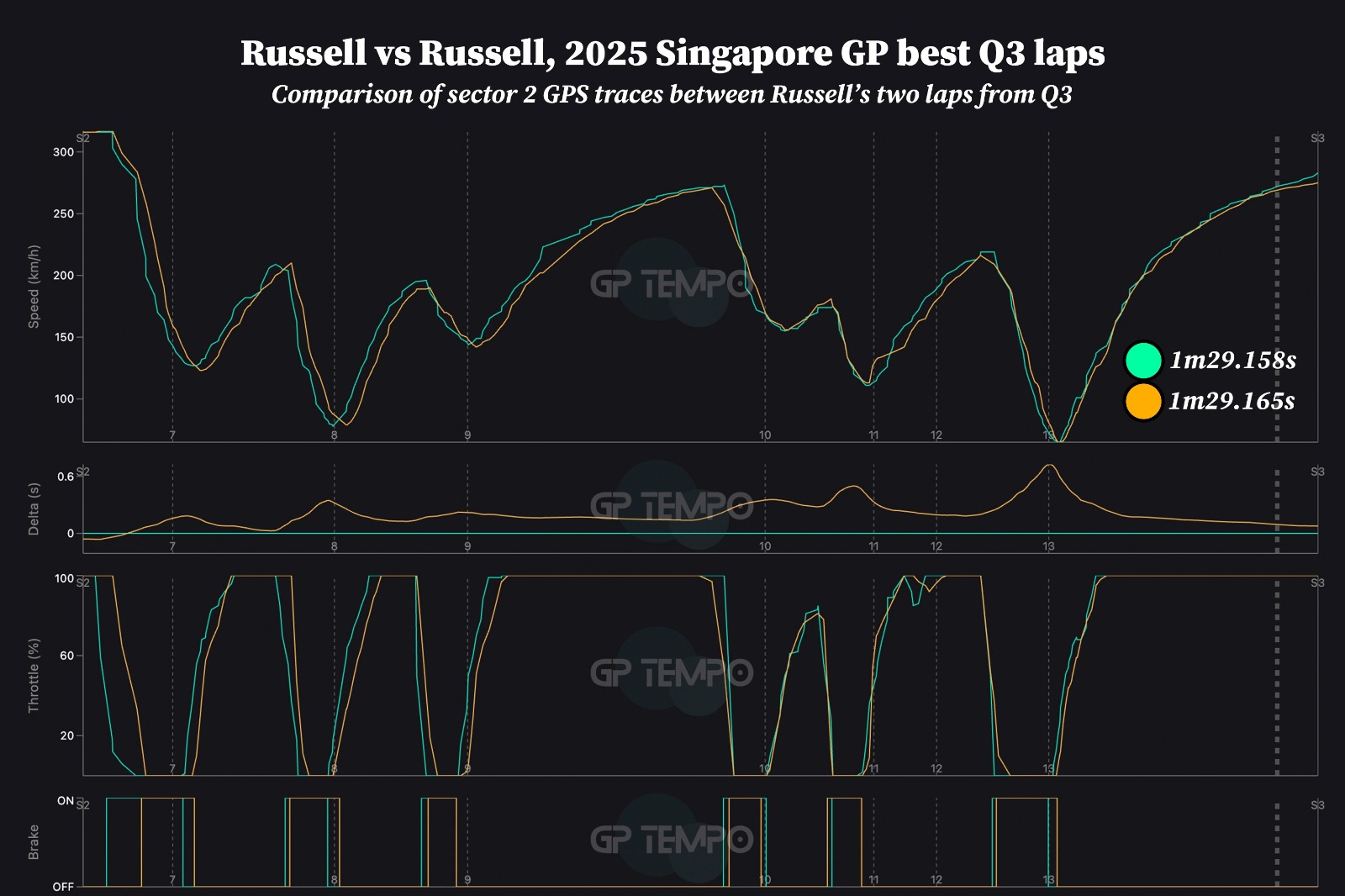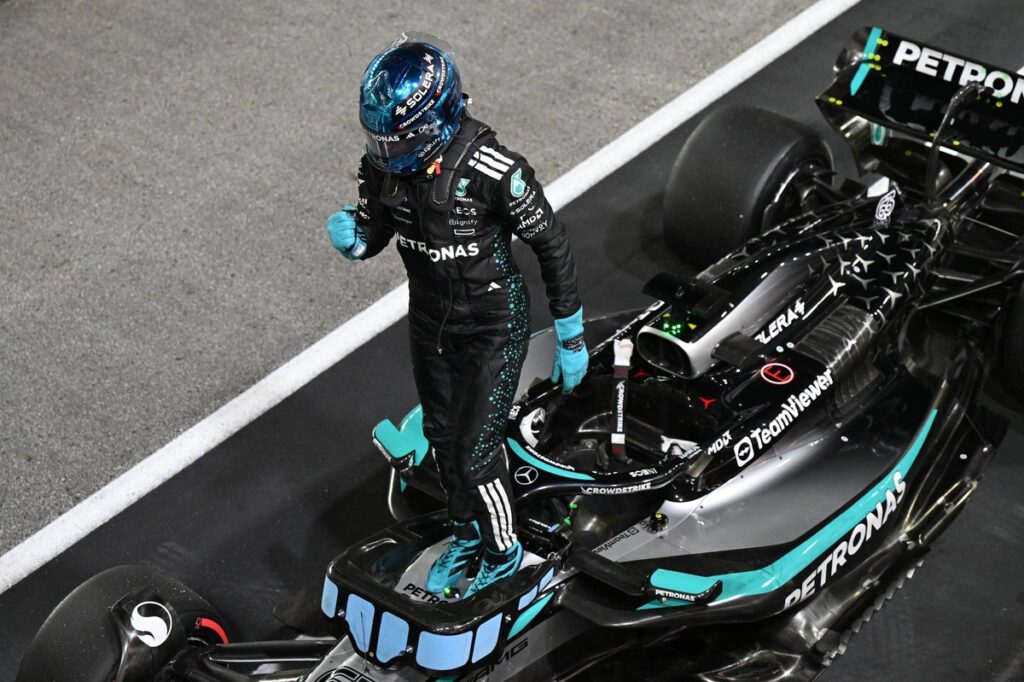After Friday’s practice sessions, George Russell had never really factored in the discussion for pole at the Singapore Grand Prix pole – particularly after his FP2 shunt.
Thus, a day made all the difference, as he reeled off two laps that were ultimately good enough to start from the front in tomorrow’s Formula 1 race. The initial 1m29.165s he’d set was a colossal statement of intent despite his wall-bang on the exit of Turn 17; the 0.007-second upgrade he uncovered on his second lap was a final little flourish in securing his second pole of 2025.
That time was almost all made up in the final corner, as Russell was a smidgen off his earlier benchmark in the first sector, quicker in the second sector on his second lap, and tracking slower in the final sector before carrying a little more speed in Turns 18 and 19. Perhaps it was the touch with the wall at the end of the first Q3 lap that made the improvement possible…
The GPS data makes for interesting reading. Russell looked a little more tentative in the opening sector on the second time around (teal) versus his traces from his Q3 benchmark (yellow). He braked a little earlier for each corner in that opening part of the lap, but got the power down a little bit sooner. Still, he was 0.11s off his best out of Turn 3, although managed to reduce that with the greater acceleration experienced on the exit of the corner.
Photo by: GP Tempo
It was a similar scenario to Turn 5, where he took an earlier braking stance and was a bit slower through the cornering stage, but hit the top end a little bit sooner under acceleration. At the end of the first sector on the Raffles Boulevard run to Turn 7, he was 0.06s off his earlier best.
On that eventual pole lap, Russell then got a foothold and found a bit more time under braking for Turn 7. The slow-in-fast-out approach seemed to work nicely in the point-and-squirt 90-degree corners at the start of sector two, buying himself more time on the accelerator through the exit of Turn 9.
Now, Russell was just shy of 0.15s up on his previous best. He was a bit more daring on the brakes for Turn 10, coming off the throttle much later than his earlier attempt at the corner, and maintained the stability at the rear end while braking for the following chicane.
Russell was in a bit of a rhythm through here, the part of the course where he crashed on the final lap of 2023’s thrilling Singapore encounter, but perhaps didn’t carry as much speed through the tight Turn 13 left-hander as he spooled up for the straight along the esplanade. A tiny throttle lift counteracted a bit of rear-end lightness, which kept him in the game but stripped him of the advantage that he’d built up over the lap.

Photo by: GP Tempo
He was still 0.077s up on his delta at the end of sector two, but the exit from Turn 14 ahead of the back straight ultimately cost a fraction of time once he’d equalised on the throttle. But the moment that threatened to derail his lap emerged in the Turn 16-17 chicane, in which he braked earlier – and for longer – than the first effort. To compensate, Russell booted the throttle a little bit more between the two corners, keeping the Turn 17 speed up.
While down on his delta out of Turn 17, maintaining the exit speed gave him a bit more forward momentum to attack the final double left. Key to this was in Russell leaving about 4-5% more throttle on through the slowest point on entry, ensuring he just about had enough acceleration to recover the 0.007s margin of difference between the two tours. Had the finish line come any sooner, he’d have been about a hundredth behind.
Photo by: GP Tempo
Does Verstappen’s dirty air grievance hold water?
After qualifying, Max Verstappen theorised that the dirty air shed from Lando Norris’ car as the McLaren returned to the pitlane had cost him a shot at pole. “It would have been close,” Verstappen said, as he found himself around two-to-three seconds behind the McLaren through the final corners, rather than the ideal six-seven second gap.
Verstappen had braked later for Turn 16 than Russell. As such, he ended up going a little bit off-line and ended up with more to make up in Turn 17 as he’d missed the apex. His minimum speed for Turn 16 was about 10kph down on Russell as he had to brake for a bit longer to keep the car between the white lines, and took more kerb from Turn 17 than he’d have liked.
In the immediate exit of Turn 17, Verstappen’s delta to Russell was climbing and was about 0.33s by the time he chose to abort his lap.
Norris is already at Turn 17 when Verstappen is braking for Turn 16. Verstappen then drops deep into the corner, presumably caught short by the reduction in front-end downforce left by the final whispers of turbulence.
Photo by: GP Tempo
Is this going to produce a tangible effect on Verstappen’s lap? Potentially, as much as a very subtle breeze would, but it feels a bit feeble to pin the blame on a driver for disturbing the air in front of him too much.
If Verstappen brakes for that corner a couple of metres sooner, he makes Turn 16 at the right angle and potentially has the acceleration to emerge from the last three corners fractions clear of Russell.
The dirty air debate is one for another day, but any physical object travelling at some velocity is going to shed wake, and it’s up to the drivers to accommodate for that. This is F1; as much as a slipstream may giveth on certain tracks, turbulence may taketh away.
Max Verstappen, Red Bull Racing, George Russell, Mercedes
Photo by: Sam Bagnall / Sutton Images via Getty Images
We want to hear from you!
Let us know what you would like to see from us in the future.
Take our survey
– The Autosport.com Team
Read the full article here

